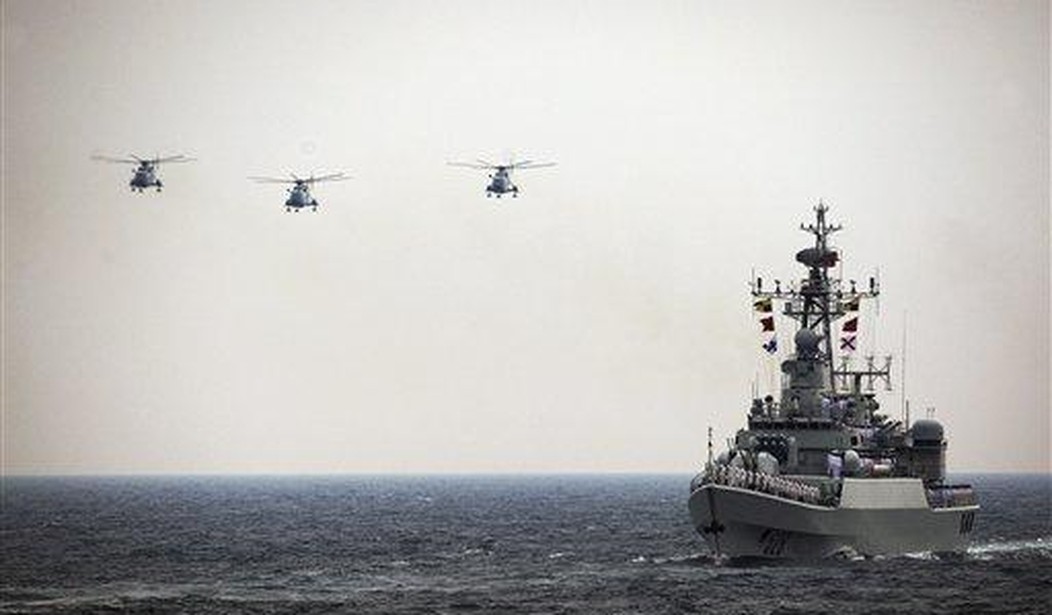In the middle of China’s Taklamakan desert, a military range complex outlines a full-scale footprint of a US Navy aircraft carrier and its Aegis missile cruiser escort. According to a November 7, 2021 article by the US Naval Institute, the fully instrumented range is a testing ground for China’s anti-ship missile program.
China Builds Missile Targets Shaped Like U.S. Aircraft Carrier, Destroyers in Remote Desert
The US aircraft carrier has been the queen of the ocean since World War 2. US Task Forces have projected US power and dominance for seventy-five years besieging and bombarding the enemies of America repeatedly. They have imposed order as defined by the United States on the ocean and land mass alike. Wherever they appear, no nation can challenge them.
During the Cold War, the Soviet Navy competed with the US Navy but never truly challenged the dominance of the US floating airbase nuclear-powered attack carriers. The Aegis cruiser is a purpose-built escort to the aircraft carrier. Its mission was to slug it out with the Soviet Navy defending its queen from an intense barrage of incoming missile threats. It is a supremely capable defender able to engage anything that comes in its direction from land, sea, or air. It is the one ship that must be overcome to pose a credible threat against a US carrier task force.
Per the USNI report, the Chinese have their sights on doing just that. They are continuing to improve their anti-ship missile technology, a critical capability if they are to ever equal or exceed the threat capability that can overwhelm the defenses of an Aegis and get to the prized US queens of the sea.
Unfortunate Parting Gifts
A sophisticated instrumented range in China is a serious investment in the delicate art of weapons development. It indicates a technology approach to the platforms, electronics, and techniques of overcoming US defenses.
It didn’t help that the US recently left a fully operational Counter Rocket, Artillery, Mortar (C-RAM) Intercept System in Afghanistan. The ground-based system is a cousin of the Phalanx gun system first developed as part of the anti-ship missile defenses of the US Navy.
Coming into possession of one by an adversary is an event that potentially sets off a bit of a mini-arms race with the adversary seeking to understand and exploit and vulnerabilities they find in that C-RAM. And the US looking hard at how to upgrade the system so that it is not vulnerable to enemy countermeasures,
This is what happens in the back and forth of weapons technology.
A Large Coastal Navy
The Chinese Navy is now larger than the US Navy. USNI also recently reported that China now has three-hundred fifty-five (355) ships, more than the US Navy’s two-hundred ninety-seven (297) ships.
China Has World’s Largest Navy With 355 Ships and Counting, Says Pentagon
But the Chinese Navy remains primarily a coastal force. Only a few blue water capital ships are part of the Chinese naval force, as opposed to the much heavier global oceans capability of the United States. Most Chinese ships are designed to sortie in the Sea of Japan, the Formosa Strait, and more recently, the South China Sea, where the Chinese government covets both influence and resources.
Many of these coastal ships carry anti-ship missiles, whose capabilities continue to need improvement as the Chinese seek to come closer to being a credible threat to their neighbors and their backstop defender, the US Navy.
The Chinese also develop coastal battery launched anti-ship systems, not unlike the cannons that guarded the coastal boundaries of nations in the past. The Chinese now use the Spratly Islands in the South China Sea as an unsinkable ship in their efforts to impose their version of force projection with economic objectives for the resources of the region, a form of power projection like the US use of the islands of Hawaii and Guam in the Pacific Ocean and Diego Garcia in the Indian Ocean.
An Increasingly Maritime China
China has become a maritime economy. They are the biggest shipper of goods around the planet. Cargo ships bring imported raw materials in from around the globe. The lifeblood of their nation depends on unfettered access to the ports of the world.
To keep China upwardly mobile, the government has embarked on an ambitious agenda of deal-making, foreign aid, infrastructure acquisition, industrial modernization, and technological development to dominate the global supply chain. China’s merchants are vertically integrating everything they can, collecting pieces of the global manufacturing and shipping industrial base. Fleets of freighters ply the oceans like Spanish galleons of old bringing riches to the empire. Far-flung sources needed for production are extracted to be shipped to the industrial cities of China. China has become the Spain of the 21st century, practicing a late form of industrial colonialism.
Once the survival of your people becomes dependent on the bounties of the sea, the one thing you cannot afford when you become dependent on a maritime economy is to have your access to the ocean interrupted because of restrictions on freedom of navigation or blockades that may arise from disagreements with other powerful nations.
In the year 2021, one nation’s navy has the power to control the oceans. The US Navy and its aircraft carrier task forces have the ability to project US power anywhere on earth with impunity.
In peacetime, it means the United States is the world’s guarantor of the freedom of the shipping lanes, a task for which its navy is second to none. For now, the Chinese seem content to leave the global guarantee of freedom of the seas to the United States.
Rising Tensions
But relations between the United States and China may not always be so congenial. Chinese self-interest increasingly comes into conflict with the national interests of America. It is conceivable that the time may come when those disagreements could rise to the point of economic conflict in what analysts refer to as Grey Zone Warfare, a heightened state of tension just short of open warfare.
Provocations between the two countries over freedom of navigation are now commonplace. The US Navy sorties ships to pass close to the Spratly Islands in the South China Sea on a regular basis, an area where the Chinese frequently exert forceful control over the ships of lesser nations in the area, something the US deems unacceptable and is actively assisting the other nations in the region to build their ability to resist Chinese pressure.
In response, in August-September of 2021, the Chinese Navy sortied a four-ship flotilla sailing within 46 miles of Alaska’s Aleutian Islands. According to Business Insider, “The People’s Liberation Army Navy task force, comprising a guided-missile cruiser, a guided-missile destroyer, a general intelligence vessel, and an auxiliary vessel, was conducting military and surveillance operations in the Bering Sea and North Pacific Ocean.”
China’s state-affiliated Global Times, goaded the US, saying that China intends to do more freedom of navigation demonstrations as far as Guam and Hawaii in the future.
Hopefully when Chinese warships pass through the Caribbean Sea or show up near Hawaii and Guam one day, the US will uphold the same standard of freedom of navigation. That day will come soon. pic.twitter.com/7fRn8PVZuS
— Hu Xijin 胡锡进 (@HuXijin_GT) September 8, 2021














Join the conversation as a VIP Member